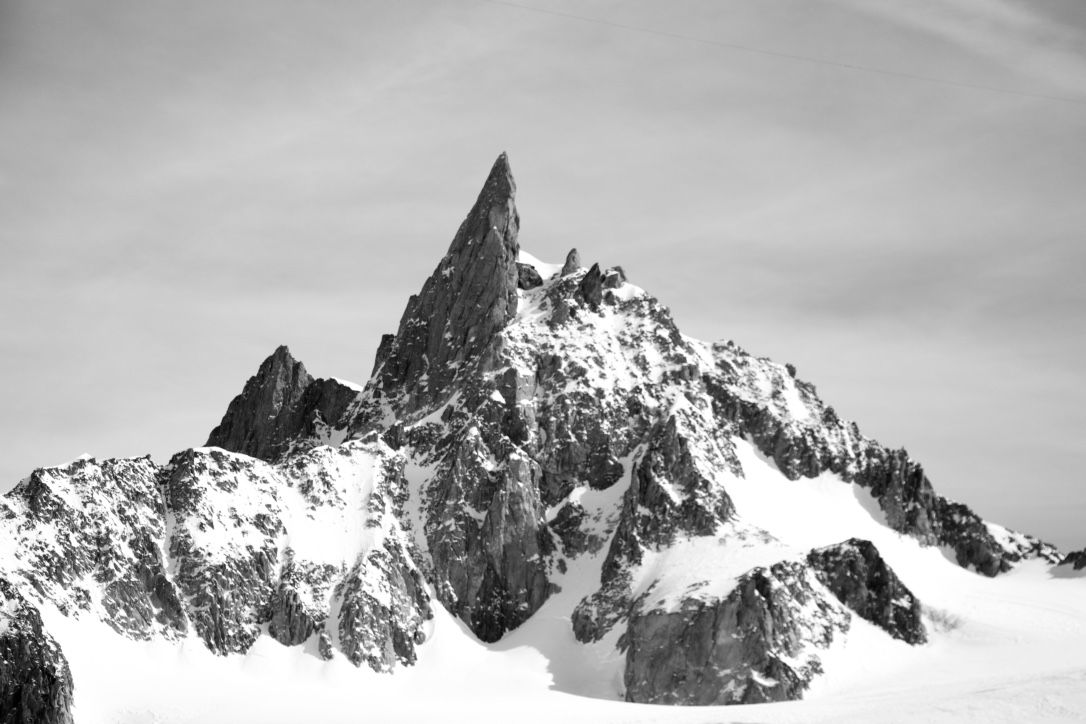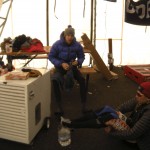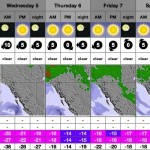Ski mountaineering racing is all about feats of endurance in extreme mountain environments but sometimes we get a bit spoiled with beautiful weather. We can’t all be freezing our butts off in Calgary all winter (nor do we want to) so travelling to a race in the Rockies during cold weather can be a bit of a shock to the system.
Don’t Get Frostbite:
Frostbite is the biggest risk during a cold race. It can be difficult to recognize when you are moving fast and can have serious consequences. Sure, we see pictures from early Himalayan expeditions with climbers coming back short a foot or a bunch of fingers and think that could never happen during a race right? Well of course it is pretty unlikely to lose an appendage during an hour and a half long skimo race but it is still possible to do serious, long-lasting damage. Anyone who has dealt with it will be quick to tell you how much it sucks.
- Wind highly increases the odds and severity of frostbite. Pay attention to the forecast to see if wind will be a factor. In the Rockies, you can pretty much count on wind.
- Exposed skin is most at risk. Cover it up – Buffs are awesome. Use it as a neck gator or pull it up over the back of your head like a balaclava.
- Creams and emollients do not work. In fact, creams can actually increase the likelihood of frostbite (see the Finnish study at the bottom) and water based creams are especially bad. Use fabric or moleskin to cover your face. Moleskin patches can be cut into squares and applied on your upper cheeks or across your nose.
- A wind vest can be incredibly useful. I love my ski suit as much as the next guy but a good fitting vest will help keep your core temperature without restricting movement or causing overheating like a full jacket might.
- Pack extra gloves. Gloves can quickly get wet from sweat or a fall in the snow during a race. Once wet, wind can cut right though them and lots of warmth is lost through your hands. One pair of heavy duty gloves could be a finger-saver if things get really nasty on course. Mitts are also more effective than gloves.
- Gloves with wind covers are really great for long descents. I have been using the CAMP G Comp Wind Glove even in warmer weather.
- Use a ski suit with a hood. Hoods under your helmet are extremely warm. I rarely use mine but when I do it makes a huge difference. A high collar is also very helpful.
- Double up on long underwear and use long underwear with wind protection panels (wind briefs). Wind protection tops are also available and really awesome.
- Carry hand warmers. More useful on a long ski tour but not a terrible thing to have just in case. Toe warmer packets can be useful if you have already damaged your toes or have poor circulation. It only works if you have room in your boot but I use a liner sock with a toe warmer stuck to the bottom then covered with a thin smartwool sock. With this setup I’ve never had to worry during a race.
- Make sure your in-race water system is prepared for the cold. A bladder and hose will freeze at -20 no matter how insulated it is or how good you are at keeping the hose clear. A water bottle with hot liquid kept inside the ski suit, close to your body, seems to work best.
Be prepared to recognize the signs and symptoms of frostbite! It is not worth permanently damaging a toe, finger, or nose for a race. Depending on the severity, even minor frostbite can follow you for life. One bad toe can make ski touring difficult anytime it is cold.
- If you are shivering during a race, frostbite is likely happening or already happened. Add layers, race harder, or drop out. You should be sweating not shivering.
- White patchy skin is a sure sign of frostbite. Take a look around at the start line and during the warm up to make sure your friends cheeks are doing ok.
- If your toes are cold on a climb but then on a descent, miraculously “warm up” and don’t hurt, frostbite is very possibly setting in. Following painful cold, frostbite causes extremities to lose feeling making it seem like you are warming back up. This is time to add clothing and check carefully for lost feeling.
- Painful cold in your hands and fingers can be normal but if you lose dexterity (easy to notice at a transition) you may be in trouble. Change to thicker gloves!
- Any time you have lost feeling, it is time to call it quits. Head for the nearest chalet to warm up. Keep assessing your toes, fingers, and face for feeling.
Ski Racing in the Cold – Other Factors:
Stay hydrated and well fuelled: In severe cold, extra calories are required just to function let alone race. Make sure your system is topped up on energy and not starting at a disadvantage. As race delays are common in severe cold, bring enough food to continue eating during delay periods. This could involve eating a pre-race breakfast as normal but also packing a pre-race lunch in the case of a long delay (also smart to do if avalanche control delays are possible). Cold temperatures are definitely a good time to use a carbohydrate replacement like Hammer HEED. Any extra calories you can take in will be useful and warm HEED will do the trick.
Exercise-induced bronchoconstriction (EIB) is also common in ski mountaineers. High breathing frequency and frigid temperatures at altitude cause airway obstruction in 50% of racers elite racers, the majority of whom are unaware. EIB can significantly impact performance and should be discussed with a physician if an athlete has any history of asthma or difficulty breathing following a race. Cold, dry air exacerbates the severity of EIB.
This weekend at Lake Louise is shaping up to be very cold, with highs of -16 deg celsius. Unlike Nordic skiing, the ISMF does not require races to be cancelled at a minimum temperature, however the mountain may shut down operations in the case of extreme cold (for example, the race at COP earlier this season). If temperatures are below -20 celsius, the ISMF does mandate a 4th item of insulating clothing to be carried in the pack. A race delay is possible to allow temps to warm up later in the day but here’s hoping for some slightly warmer temps and no postponements!
Resources:
- F. Durand, P. Kippelen, F. Ceugniet, V. R. Gomez, P. Desnot, M. Poulain, C. Préfaut. Undiagnosed Exercise-Induced Bronchoconstriction in Ski-Mountaineers. Int J Sports Med 2005; 26(3): 233-237
- Lehmuskallio E. Emollients in the prevention of frostbite. Int J Circumpolar Health. 2000 Apr;59(2):122-30.





I can’t agree more on a lot of these points, windproof underpants being one of the all-time best inventions! Also, from a race as opposed to safety standpoint, really careful skin management is crucial so you don’t spend the whole race kicking @#%^ing skins. What do you think about Dermatone and the like for protecting your face from the wind? That along with a healthy beard kept me skiing at Jackson this year, and I like to think that it helps in general. Placebo?
Thanks for the post.
Andy – Take a look at the reference I just added. Creams can generally be a problem. A beard is definitely more effective 🙂
Eric I agree with most of what you wrote, however, I disagree with the creams not working. Have you tried Warmskin? If applied properly and at least 30 minutes prior to exposure, it does work. Anne Bancroft used it along with the NFL players and more. I have personally used it and had parts exposed for many hours at a time in windchills -40 or more and temps below zero. One way to alleviate the EIB and keep your face dry and glasses from fogging is to use the Lungplus. I also highly recommend goggles to protect the eyes and kinesio tape for the cheeks because the foam on the goggles will get wet and may freeze.
Eve – If you’ve seen any medical journals or other peer reviewed research that support Warmskin, I’ll eat my words but until then, NFL players using it is not terribly convincing. Much more effective is covering the area with clothing or as you mention, tape.
I’ve never used the Lungplus but I can see how it would be useful to prevent EIB.
Would you be interested in testing a Lungplus? When temps are this cold, it’s night and day for everyone!
Eric,
We at Warm Skin have never advocated our product as a sole protector of skin in frigid weather.
We always recommend good judgment and some kind of face covering in severe weather.
We were part of a New York Times Gear test published on February 22, 2007 comparing 5 other products.
This what the ski instructor, Christine Wilmott, said about Warm Skin:
..” A slight amount of water in this cream helps moisturizing oils be ab-
sorbed. It was “easy to spread” and was effective against wind and cold, Ms.
Wilmott said. “I wore it for five hours and didn’t need
to reapply,”she said.But it has no SPF. And despite its
name, the cream doesn’t literally warm skin.
This test was performed for several days in temperatures ranging from mid teens to sub-zero
with strong, gusty winds.
Maddie Phaneuf, a USA Team Biathlete member, has been using Warm Skin since she was 8. Since 1985,
we have talked with nordic skiers, mushers and every day winter enthusiasts who have testified to Warm Skin”s
effectiveness.
We agree that nothing works well with feet and hands as well as what was suggested above by Eric. Another important point. Skin conditioning well ahead of any winter endeavor keeps skin supple and less likely to
crack or incur frostbite. Warm Skin is another tool in a winter tool box.
Thank you for the opportunity to speak to your comments.
As the manufacturer of Warm Skin, we can agree that skin creams will not alone protect from frostbite.
We urge all outdoor enthusiasts to use good judgment and adequate coverage in extreme temperatures.
However, Warm Skin does slow down trans-epidermal water loss from exposed skin. The moisture in your skin holds the body’s warmth. Key is the fact that since 1985 countless outdoor enthusiasts and athletes have attested to the effectiveness of Warm Skin. Not only have we numerous testamonials, but it has been gear tested in many public forums, in conditions ranging in teens to sub zero temperatures and in strong gusty winds. Warm Skin has provided protection up to 5 hours without reapplication in comparison tests with other national brands.
Keeping skin deeply moisturized well ahead of exposure is critical in preventing brittle skin which leads to frostbite. Our peers are the people who use Warm Skin rather than labs tests that simulate environmental stressors.